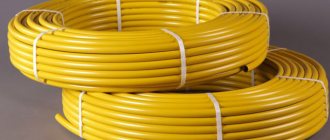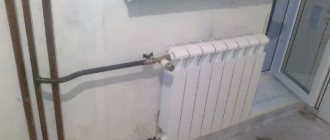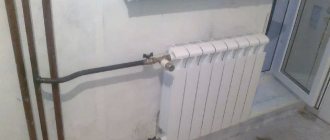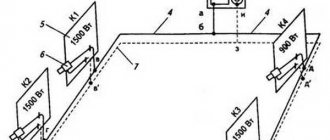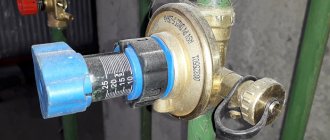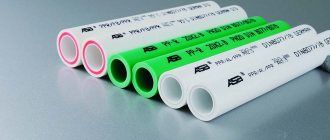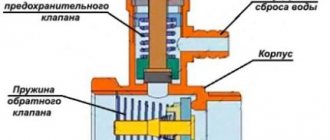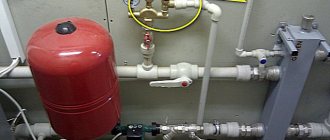A well-made water supply system will last for many years without breakdowns. However, when installing it, the diameter of the pipes must be selected in accordance with the requirements and construction standards. Therefore, when planning to install plumbing in your home, you need to know how the throughput of a pipe is determined depending on the diameter and pressure of the water. Let's figure out why this is so important and how to take measurements correctly.
Water pipes must have a throughput capacity appropriate to their tasks Source znatoktepla.ru
How to choose the correct pipe diameter
When laying pipes for plumbing or heating, you need to choose a size that will provide the right pressure, but will also be loose enough for water to pass through easily. It is important to take into account the following:
- Pipe cross-section diameter.
- The amount by which the pressure in the area under consideration will decrease.
- The speed of water flowing through a pipe.
- The highest possible pressure that the pipe must withstand.
- The length of the pipe sections and the material from which they are made.
In practice, the diameter is often selected based on the use of a special table. This method is simple, however, it is one of the least accurate.
Steel pipes Source www.1metallobaza.ru
Application of the tabular method
In this case, the most typical values of the main parameters were used to create the lookup table. To calculate water flow by pipe diameter and pressure, the table should be used as follows:
- The top line of each column lists the nine most common pipe diameters.
- The lines indicate the pressure value.
- The left column contains values expressed in Pascals per meter, the next column in millibars per meter (atmospheres).
- Selection can be made taking into account the speed of water flow. The table shows water consumption in accordance with the pipe diameter and other parameters.
Table for determining the pipe capacity Source vannayasovety.ru
In most water supply systems, the pressure is in the range of 1.5-2.5 atmospheres. In houses with large number of storeys, it is common to use several separate segments. Therefore, these tables also apply to multi-storey buildings.
Relay costs
The Internet is a best-effort network, which means that packets will be delivered if possible, but may also be dropped. Packet dropping is adjusted by the transport layer, in the case of TCP; there is no such mechanism for UDP, which means that either the application does not care if some parts of the data are not delivered, or the application itself does the retransmission over UDP.
Retransmission reduces useful performance for two reasons:
A. Some data needs to be sent again, which takes a long time. This introduces a delay that is inversely proportional to the speed of the slowest link in the network between the sender and the receiver (aka the bottleneck). b. Detecting that some data was not delivered requires feedback from the recipient to the sender. Due to propagation delays (sometimes called latency; caused by the finite speed of light in a cable), feedback may only be received by the sender with some delay, further slowing the transmission. In most practical cases, this is the most significant contribution to the additional delay caused by retransmission.
It is clear that if you use UDP instead of TCP and don't care about packet loss, you will of course get better performance. But for many applications, data loss is unacceptable, so this measurement is not meaningful.
There are some applications that use UDP to transfer data. One is BitTorrent, which can use either TCP or a protocol they developed called uTP, which emulates TCP over UDP but aims to be more efficient when using many parallel connections. Another transport protocol implemented over UDP is QUIC, which also emulates TCP and offers multiplexing of multiple parallel transmissions over a single connection and forward error correction to reduce retransmissions.
I'll discuss forward error correction a bit as it relates to your question about throughput. The naive way to implement this is to send each packet twice; in case one gets lost, the other still has a chance to be retrieved
This cuts the number of retransmissions in half, but also halves your useful performance since you are sending redundant data (note that the network or link layer bandwidth remains the same!). In some cases this is normal; especially if the delay is very high, for example on intercontinental or satellite channels
Moreover, there are some mathematical methods where you don't need to send a complete copy of the data; for example, for every n packets you send, you send another redundant packet, which is an XOR (or some other arithmetic operation) of them; if the extra one is lost, it doesn't matter; if one of the n packets is lost, you can recover it based on the redundancy of one and the other n-1. This way, you can configure the overhead introduced by forward error correction for whatever amount of bandwidth you can save.
Why do you need to correctly determine pipe parameters?
Of course, it is clear that in a complex technical system everything must be accurately calculated. However, the question remains about what bad things can happen if the pipes are not properly sized.
Use of polypropylene pipes Source www.tk-stroyresurs.ru
The water consumption and drainage system in an apartment is highly interconnected. An open faucet in the kitchen can reduce the flow of water in the bathroom or stop the flow of water to flush the toilet. It is important to understand that this can be caused not only by improper installation of equipment, but also by clogging of pipes over time.
For example, metal products rust over time and become coated on the inside with deposits from insufficiently clean water. Plastic ones do not have this drawback. They do not become dirty or destroyed over a long period of time.
If pipes are too narrow, drainage problems may occur. Excessive pressure in the water supply network will lead to leaks and increased accident rates.
Calculation of pipes is important when supplying water and drainage for a multi-story building. In this case, the pipes must correspond to each other. Suitable outside and those through which water flows inside.
Metal-plastic pipes are known for their reliability and durability Source images.ua.prom.st
When paying utility bills, companies and organizations do not always use meters. In these cases, the bill is usually presented according to the patency of the pipe.
Pipes in a home can serve various functions. They relate to the supply of hot and cold water, pressure or non-pressure sewerage, natural gas supply, and heating. In each of these cases, they are presented with requirements that they must meet.
Communications in the house will work without creating problems if their bandwidth is determined correctly. Otherwise, you will have to repair them.
Nuances of the heating circuit
To design a heating system with high quality, you need to use reinforced polypropylene pipes. It is very important that they comply with GOST R 52134-2003. Such products are best protected from deformation. In addition, they do not significantly change their linear dimensions under the influence of hot water.
To arrange the heating circuit, it is advisable to use structures reinforced with aluminum foil or fiberglass. Each version of the listed products has its own strengths and weaknesses. Channels reinforced with fiberglass are more convenient, since during installation there is no need to remove the aluminum layer.
To calculate what diameter pipes to use, you need to consider:
- temperature difference between the supply and return circuits;
- fluid velocity indicator (standard - 0.6 m/s);
- room size.
What determines the permeability of a pipe?
To determine the rate at which water is consumed, several different factors must be taken into account. At first glance, it may seem that for this we can limit ourselves to taking into account only the diameter of the pipe.
When calculating pipe parameters, it is necessary to correctly determine the internal diameter Source stroyobzor.info
In practice, it is necessary to take into account a number of factors:
- It is necessary to take into account the length of the pipe segment through which the liquid moves. The importance of this parameter is based on the presence of friction between the walls and the liquid. The longer the pipe segment used, the more it can slow down the flow of fluid.
- Although the initial pressure plays an important role, the slowing flow of the liquid will not allow new portions to enter the pipe for some time.
- The diameter affects the flow rate. However, it affects the liquid in several ways. When using narrow pipes, the degree of deceleration increases sharply.
- Various materials can be used for the walls. In plastic pipes, water flows at a higher speed than in metal pipes of the same diameter.
PVC pipes do not overgrow from the inside during operation Source aquaplast.ru
- The time during which the pipes are in use. This parameter does not have a significant effect on plastic pipes, but is important for metal ones. Over time, they become overgrown from the inside and rust. This negatively affects their cross-country ability.
- Different segments are connected using fittings, forks, and adapters. They slow down the passage of water. The braking they provide must be taken into account in calculations.
If, when determining cross-country ability, you ignore at least one of the above features, this can change the calculated value several times.
Tables for determining diameter and wall thickness Source vse-o-trubah.ru
Signal transmission methods
Today, there are three main ways to transmit signals between computers:
- Transmission over radio networks.
- Data transmission via cable.
- Data transmission via fiber optic connections.
Each of these methods has individual characteristics of communication channels, which will be discussed below.
The advantages of transmitting information via radio channels include: versatility of use, ease of installation and configuration of such equipment. Typically, a radio transmitter is used to receive and transmit data wirelessly. It can be a modem for a computer or a Wi-Fi adapter.
The disadvantages of this transmission method include unstable and relatively low speed, high dependence on the presence of radio towers, as well as the high cost of use (mobile Internet is almost twice as expensive as “stationary” Internet).
The advantages of data transmission via cable are: reliability, ease of operation and maintenance. Information is transmitted through electric current. Relatively speaking, a current at a certain voltage moves from point A to point B. A is later converted into information. The wires can withstand temperature changes, bending and mechanical stress very well. The disadvantages include unstable speed, as well as deterioration of the connection due to rain or thunderstorms.
Perhaps the most advanced data transmission technology at the moment is the use of fiber optic cable. Millions of tiny glass tubes are used in the design of the communication channels of the communication channel network. And the signal transmitted through them is a light pulse. Since the speed of light is several times higher than the speed of current, this technology has made it possible to speed up the Internet connection several hundred times.
The disadvantages include the fragility of fiber optic cables. Firstly, they cannot withstand mechanical damage: broken tubes cannot transmit a light signal through themselves, and sudden temperature changes lead to their cracking. Well, the increased background radiation makes the tubes cloudy - because of this, the signal can deteriorate. In addition, the fiber optic cable is difficult to repair if it breaks, so it has to be completely replaced.
The above suggests that over time, communication channels and networks of communication channels are improved, which leads to an increase in data transfer rates.
Sources
- https://ProTryby.ru/kak-rasschitat-propusknuyu-sposobnost-truby
- https://protruby.com/informatsionnye-stati/propusknaya-sposobnost-trub.html
- https://fb.ru/article/343444/propusknaya-sposobnost-kanalov-svyazi-skorost-internet-soedineniya
- https://TrubyGid.ru/propusknaya-sposobnost-truby
- https://trubanet.ru/vodoprovodnye-truby/raschet-raskhoda-vody-po-diametru-truby-i-davleniyu-po-tablice-i-snipu-2-04-01-85.html
- https://www.calc.ru/gidravlicheskiy-raschet-truboprovoda.html
How to calculate pipe patency
When it becomes necessary to make calculations, it is possible to use the following methods:
- Use tables. There are various options that suit the purpose of the pipes.
- Apply formulas. There are several calculation options. Simplified options are often used that do not take into account all the essential features of the plumbing system.
- There are software products designed to carry out the calculations in question. They usually give the most accurate results.
- Online calculators may be used. In order to use them, you must go to the appropriate page and enter the required data in accordance with the instructions.
Below we consider several ways to carry out calculations.
Tables for determining bandwidth Source ytimg.com
See also: Catalog of companies that specialize in utilities and installation of swimming pools
Using a simplified formula
Thus, based on knowledge of the pipe diameter and flow speed, permeability can be determined. To do this, you can use the following formula.
q = (V*Pi*d^2) / 4
The following notations are used here:
- q – permeability, expressed in liters per second;
- V denotes water speed;
- d represents the inside diameter of the hole.
In most cases, the speed is in the range of 0.8-1.5 meters per second. If a pump is used, the pressure and flow rate it produces are indicated in the technical data sheet.
More accurate formula
In this case, it is necessary to use the Darcy formula. It takes into account:
- Length of pipe segment used (L).
- A coefficient that expresses the degree of flow inhibition due to wall friction, the use of various types of fittings, wall curvature and turbulence. It is called the roughness coefficient (lambda).
- The value of liquid viscosity (rho).
Table of roughness coefficient values for each type of pipe (lambda) Source ok-t.ru
The formula looks like this.
PN = lambda * (L/D) * ((V^2)/(2*g)) * rho
The following notations are used here:
- PN represents the head loss. The calculated water consumption should be reduced by this amount.
- L is the length of the pipe through which water flows.
- D is the internal diameter of the pipe.
- g is equal to the magnitude of the acceleration due to gravity.
Using the Darcy formula, you can take into account the characteristics of pipes, but for this it is necessary to determine the “lambda” and “rho” coefficients.
Using online calculators
In order to calculate the pipe capacity, a calculator is easy to find online. To do this, you can use Google, Yandex or others search. To do this, in the search bar you need to type the line “how to calculate the permeability of a pipe, calculator” or similar.
To calculate water flow by pipe cross-section and pressure, the calculator will ask you to enter the following data:
- Material for production.
- Type (design features). Here you need to make a selection from the drop-down list.
- Next, you need to indicate the purpose of the calculation. One of them is calculating water consumption.
When calculating the pipe diameter based on water flow, you will additionally need to indicate the pressure drop per meter, the internal diameter of the pipe and the length of its section. After clicking the button, the desired result will appear on the page.
Example of a calculator interface for hydraulic calculation of a pipeline Source calc.ru
In the second case, before calculating water consumption by pipe diameter and pressure, it is necessary to prepare data on the type of water supply system, structural features of the pipe, length, diameter, material of manufacture, temperature and pressure.
An example of a calculator interface for calculating pipe capacity Source trubanet.ru
information theory channel 2 bandwidth
I've read a few articles online and I've got a pretty good understanding of TCP and UDP in general. However, I still have some doubts that I'm sure are not entirely clear to me.
( )
UPDATE:
I realized that TCP uses windows, which are nothing more than many segments that can be sent before they actually wait for the Thank You. But I doubt UDP segments are constantly being sent without even worrying about Thanks. Thus, there is no additional overhead in UDP. Then why is TCP throughput so much higher than UDP throughput?
And finally
This is true ?
If this is the case, then the TCP throughput is always equal to the Know Link speed. And since RTT cancels each other out, TCP throughput doesn't even depend on RTT.
I have seen in some network analysis tools like iperf, throughput benchmark, etc. that TCP/UDP throughput varies with block size.
How is the water supply arranged in an apartment or house?
Although the internal diameter is essential when calculating water consumption, it can sometimes be difficult to determine. Special tables may be used for this purpose, but information may not be found here for all brands of equipment.
Installation of water supply Source san-kras.ru
If it is possible to directly measure the desired value, then it should be used for calculations. However, this method is convenient when using plastic or metal-plastic pipes.
If we consider metal ones, then over time they become overgrown from the inside, and this happens unevenly. Therefore, in this case, it is difficult to directly calculate water consumption. Usually, to compensate for the narrowing, pipes of a slightly larger diameter are taken compared to the calculated one.
Video description
You will see how to choose the correct pipe diameter in this video:
In practice, in apartments or private houses, they usually use products with a diameter of 10 or 15 mm for water pipes, and 20 or 25 mm for risers. If equipment with dimensions specified in inches is used, values close to those specified are used.
It is generally accepted that the maximum permissible flow rate of water in a water supply system is 2 meters per second. The diameter is selected depending on the length of the pipe:
- In cases where this value does not exceed 10 meters, it is sufficient to use a pipe with a diameter of 20 mm.
- In the case where its length ranges from 10 to 30 meters, using a pipe with a diameter of 25 mm is suitable.
- When the pipeline section is longer than 30 meters, you can take a product with a diameter of 32 mm.
- For a length of more than 50 meters, pipes with a diameter of 50 mm are suitable.
- For even larger sections of the pipeline and in the presence of numerous water intake points, the required value reaches 100 mm.
Rules for selecting the size of the main line
To determine the optimal value of the internal diameter of polypropylene pipes, calculations are performed using the initial data as a base:
- The speed at which the medium moves through the pipes;
- Water consumption rate.
If the object is a private house or mansion, then to determine the diameter of the polypropylene products on the basis of which the water supply system will be built, you should use the formula:
D=√((4)-Q-(1000/π∙v))
where v is the speed of the passing flow, m/s (taken from 0.7...2 m/s);
π – Pi number equal to 3.14.
Directly at the stage of selecting pipes for water supply, they most often focus on a diameter of 20 mm.
Calculating the diameter for polypropylene pipes has its own peculiarities when it comes to a multi-story building. Here, at each stage of construction, the parameter value is adjusted. The reason for this is due to differences in the supply of water to a separate apartment, entrance, house, block, microdistrict. The basic rule that is observed here is that as the rate of water consumption increases, the diameter of the main line also increases.
When installing water supply systems for apartment buildings, polypropylene pipes with the following dimensions are most often used:
- when installing risers in five-story buildings - 25 mm;
- when creating wiring inside residential premises - 20 mm;
- when installing risers in buildings with 9 or more floors - 32 mm.
Video description
What is pressure loss and how to determine it - watch in this video:
When calculating the pipeline capacity, all points in the house where water consumption occurs and consumers that can be connected simultaneously to the water supply system must be taken into account. These include not only residents, but also devices that consume this resource. For example, this applies to the dishwasher and washing machine.
At the same time, to calculate the pipe capacity depending on the diameter and water pressure, it is necessary to take into account the peculiarities of the situation when the family is small, although there are many taps. It must be remembered that people will not be able to consume water through all taps at the same time.
For simplicity, we can assume that a fully open tap flows 6 liters of water per minute. Based on this, you can see what the maximum water consumption in the house is expected and based on this, calculate the diameter of the pipes that supply water to the house or apartment.
What is this key feature in TCP that makes it much superior to UDP?
This is false, although it is a common misconception.
In addition to relaying data when necessary, TCP will also adjust the sending rate so that it does not cause packet drops by congesting the network. The tuning algorithm has been refined over decades and typically converges quickly to the maximum speed supported by the network (in effect, the bottleneck). For this reason, it is usually difficult to beat TCP in throughput.
With UDP there is no rate limit for the sender. UDP allows an application to send as much as it wants. But if you try to send more than the network can handle, some data will be deleted, which will reduce your throughput and also make the network administrator very angry at you. This means that sending UDP traffic at high speed is not practical (unless the target is a DoS network).
Some media applications use UDP, but the speed limits the sender's transmission to very little speed. This is typically used in VoIP or Internet radio applications where very little bandwidth but low latency is required. I believe this is one of the reasons for the misunderstanding that UDP is slower than TCP; this is not true, UDP can be as fast as the network allows.
As I said before, there are protocols such as uTP or QUIC implemented on top of UDP that provide similar performance to TCP.
Different types of pipes
Various piping systems are used in a house or apartment. Requirements and calculation methods for them may differ.
For example, the calculation of pipeline capacity in terms of diameter and pressure for a sewer pipe is based on the following parameters:
- Pipeline diameter.
- Average flow rate.
- The hydraulic slope (l) under which the pipes move.
- The degree of filling of the pipe with contents (h/d). When determining this parameter, the concept of hydraulic radius is used.
Video description
This video talks about the drop in pressure when a pipe narrows:
Hydraulic slope refers to the angle at which the pipe is located, satisfying a certain condition. If the sewer pipe is located in this way, then under the influence of gravity its contents should drain in such a way that self-cleaning occurs. This value is determined on the basis of special tables.
When calculating the hydraulic radius, they are based on the actual diameter of the pipe and the degree of its filling with contents. So, for example, for a completely filled product these two radii will be equal, but with partial filling the hydraulic radius will be smaller. It is calculated based on appropriate formulas or tables.
Properly designed and installed sewer pipes will ensure good drainage and eliminate the risk that they may become clogged.
When calculating the throughput of a gas system pipe, it must be taken into account that a gaseous, not a liquid, substance spreads through them. One of the important differences is the high compression ratio.
The pipe diameter must be selected correctly Source otoplenie.site
When transporting gas, the pipe capacity depending on the diameter is calculated using the following formula.
Q = DN * 0.67 * p
This formula uses the following notation:
- Q represents the maximum capacity of the gas pipe;
- DN is equal to the nominal diameter of the gas pipe;
- p is a value equal to the operating gas pressure, which must be increased by 10%.
The throughput of a gas pipeline can be calculated using the formula given here or using a table compiled on its basis. This formula is used to calculate the parameters of pipes in residential buildings and apartments.
For calculations in industry, a different formula is used.
Q = DN2 * 196.386 * (p/z) * T
The following notations were used here:
- Q is the pipeline capacity;
- DN2 indicates the diameter of the pipe;
- z – compression ratio;
- p – pressure in the pipeline;
- T – gas temperature.
Heating pipes Source woodmaster-shop.ru
If the temperature increases, this will lead to increased pressure on the pipe walls. Therefore, when using gas, it is necessary to take into account climatic conditions, which significantly affect the permeability of the pipeline. Using a diameter that is too small increases the risk of increased gas pressure and pipe damage.
Calculation of the thermal power of the heating system
The thermal power of a heating system is the amount of heat that needs to be generated in a house for comfortable living during the cold season.
Thermal calculation of a house
There is a relationship between the total heating area and the boiler power. In this case, the boiler power must be greater than or equal to the power of all heating devices (radiators). The standard thermal calculation for residential premises is as follows: 100 W of power per 1 m² of heated area plus 15 - 20% reserve.
Let's take a house with an area of 120 m² as an example. In this case, the boiler power should be: 100 W × 120 + 15% = 13800 W = 13.8 kW. If the boiler (double-circuit) will also be used for hot water supply, then its required power should be increased in proportion to the expected consumption of heated water.
Calculation of the number and power of heating devices (radiators) must be carried out individually for each room. Each radiator has a certain thermal power. In sectional radiators, the total power is the sum of the power of all used sections.
In simple heating systems, the above methods for calculating power are sufficient. The exception is buildings with non-standard architecture, having large glass areas, high ceilings and other sources of additional heat loss. In this case, a more detailed analysis and calculation using increasing factors will be required.
Thermal engineering calculation taking into account heat losses of the house
Calculation of heat losses at home must be performed for each room separately, taking into account windows, doors and external walls.
In more detail, the following data is used for heat loss data:
- Thickness and material of walls, coverings.
- The design and material of the roofing covering.
- Foundation type and material.
- Glazing type.
- Type of floor screeds.
It is important to take into account the presence of a heat-insulating layer in the enclosing structures, its composition and thickness.
To determine the minimum required power of the heating system, taking into account heat losses, you can use the following formula:
Qt(kWh) = V × ΔT × K ⁄ 860 , where:
Qt is the heat load on the room.
V is the volume of the heated room (width × length × height), m³.
ΔT is the difference between the outdoor air temperature and the required indoor temperature, °C.
K is the heat loss coefficient of the building.
860 — conversion of the coefficient to kWh.
The heat loss coefficient of a building K depends on the type of structure and insulation of the room:
| K | Construction type |
| 3 — 4 | A house without thermal insulation is a simplified structure or a structure made of corrugated metal sheets. |
| 2 — 2,9 | A house with low thermal insulation - a simplified building design, single brickwork, simplified window and roof design. |
| 1 — 1,9 | Medium insulation - standard construction, double brickwork, few windows, standard roof. |
| 0,6 — 0,9 | High thermal insulation - improved construction, brick walls with thermal insulation, a small number of windows, insulated floors, roofing pie with high-quality thermal insulation. |
The difference between the outdoor air temperature and the required indoor temperature Δ T is determined based on specific weather conditions and the required level of comfort in the house. For example, if the temperature outside is -20 °C, and the temperature inside is +20 °C, then ΔT = 40 °C.
Briefly about the main thing
Determining the capacity of a pipe depending on the diameter and water pressure is a complex task. For this purpose, formulas, special tables, online calculators or specialized programs can be used.
Correctly selected pipes will ensure the quality and durability of the plumbing and other communication systems in a house or apartment. When calculating pipe parameters, it is necessary to take into account the magnitude of the pressure, make allowances for its drop, and take into account the length and service life of the pipes.
Features of installation work
The connection of polypropylene elements is carried out by welding on a special device. With its help, individual fragments are heated to a given temperature, and then joined together to form a solid product.
The connection of polypropylene and metal elements is carried out using fittings with threaded inserts. Sealing is ensured using Teflon tape and a number of other sealants.
Attention! Thread cutting on finished products is unacceptable! Installation should be carried out using fittings produced by the same manufacturer.
To form a quality connection you should:
- carefully inspect all connected elements to eliminate contamination and damage;
- perform work at temperatures above 5° C. Bending – above 15° C;
- maximum bending radius, depending on the diameter of the PP pipes;
- mount system elements on a fixed support only in exceptional cases, since it does not allow compensatory displacement;
- When fastening, thermal expansion must be taken into account.
You can view the details of the installation work in the following video:
